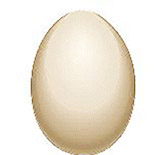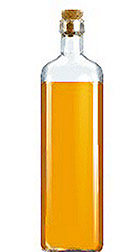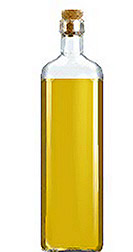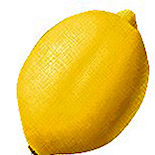Reprinted from The Blood Type Diet Website (www.dadamo.com)
| Basic Mayonnaise 2 | 
6 votes |
| Contributed by: Robin Hinsdale | Added: Oct 07, 2007 at 04:49 PM |
Description:
Basic mayonnaise recipe for all types.
For more mayonnaise recipe variations, go to Robin's blog.
Best Used By Blood Types:- Type A (2 beneficials)
- Type A Non Secretor (2 beneficials)
- Type AB (2 beneficials)
- Type AB Non Secretor (3 beneficials)
- Type B (1 beneficials)
- Type B Non Secretor (1 beneficials)
- Type O (1 beneficials)
- Type O Non Secretor (1 beneficials)
Category: | |
Ingredients:- 1 large egg (if you mix by hand, you will use only the yolk--you can freeze the whites for other use)
- 1 teaspoon (5 ml) dijon or vinegar-free mustard
- Sea salt to taste (optional)
- 2-3 Tablespoons (30-45 ml) fresh lemon juice
- 3/4 cup (180 ml) mild olive or canola oil
- 2 Tablespoons (30 ml) extra virgin olive oil (optional)
How to make it:
By Hand:
- Rinse a 1 quart (1 liter) bowl with hot water, dry and set it on the counter with a damp twisted towel wrapped tightly around the base to keep it stable.
- Add the egg yolk and whisk it vigorously back and forth until it is sticky and thick, then stir in the mustard, a pinch of salt and the lemon juice.
- Whisk in the mild olive/canola oil by droplets until the egg and oil have begun to thicken (when 1/3 to 1/2 the oil has been added), then whisk in the remaining oil in a thin, steady stream.
- Add the extra virgin olive oil at the end and season to taste with additional salt and a little lemon juice.
- To thin (if it is too thick, or you want to use the mayonnaise as a base for a sauce), whisk in lemon juice by drops, or add 1-2 tablespoons (15-30 ml) boiling water as needed.
- Cover and refrigerate until ready to use.
Blender:
- Put a whole egg, the mustard and a pinch of salt in the blender with 1/3 cup (80 ml) oil and turn it on.
- Add the remaining oil in a steady stream until all is incorporated, then add the lemon juice.
- Thin with additional lemon juice or boiling water.
Food Processor:
- Use a whole egg, 2 yolks, or a whole egg plus a yolk.
- Plan to use an additional 1/2 cup (120 ml) oil and adjust the other ingredients accordingly, to taste.
- Start with the egg, mustard, and a pinch of salt and, with the machine running, add the oil in a steady stream until all is incorporated.
- Add the lemon juice.
- The finished mayonnaise will be thick.
- To thin, add boiling water or lemon juice.
Comments:
Now let's say you're halfway through the process and nothing is happening--the oil and egg are still just oil and egg. Or you were almost done and suddenly the mayonnaise just fell apart. What happened? Your mayonnaise 'broke'--the emulsification failed. Is this total disaster? Nope.
If mayonnaise breaks:
- Whisk in 1-2 teaspoons (5-10 ml) boiling water.
- If that doesn't bring it back, start over with a new yolk and use the broken sauce as oil, whisking it in drop by drop until you have a new emulsion.
Now comes the fun part. You've got a bowlful of thick, creamy mayonnaise. What can you do with it? You can add flavors. The sky is the limit! Try salsa, chutneys (the little sandwich shop two doors down from us makes a mango chutney mayo to die for), mustard, horseradish, cayenne, mashed roasted red peppers--whatever you can imagine.
BTD Core Ingredients Analysis:
BTD Variations and Substitutions Analysis:
Oil Product(s)
| Name | Notes | A Sec | A Non | ABSec | ABNon | B Sec | B Non | O Sec | O Non |
|---|
| Olive Oil | 1 ,2 |  B B |  B B |  B B |  B B |  B B |  B B |  B B |  B B | | Canola Oil | 1 ,2 |  N N |  N N |  N N |  N N |  A A |  A A |  N N |  A A |
[1] This recipe uses ingredients which may help limit bacterial overgrowth.
[2] This recipe uses ingredients which may be genetically modified .
This recipe is low in common allergens.  This recipe is gluten free. This recipe is gluten free.  This recipe uses ecologically friendly ingredients. This recipe uses ecologically friendly ingredients. 
If an ingredient is an avoid for your blood type, then try using a BTD compliant variant/substitute or leaving the item out of the recipe.
Please Note:
When using any recipe, always check it for avoids and make the appropriate adjustments where necessary. The Blood Type Diet Recipe Database has been recently greatly enhanced. Also, the food lists changed somewhat a couple of years ago, and all recipes in the database may not reflect those changes in terms of the blood types for which the recipes are recommended. Volunteer Blood Type Diet Forums Members are working to review and update all the recipes to take advantage of the all the new features and food lists. Please be patient with us until the process has been completed.
Revision History:
- Revised Oct 07, 2007 at 04:50 PM By: Drea
|











